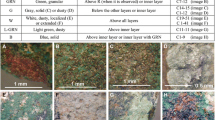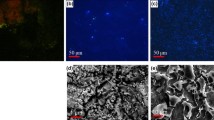Abstract
Tin-rich organ pipes are often affected by localised deterioration in the form of grey pustules, pinholes, cracks and exfoliations at the surface. Two main types of decay of tin-base materials that might have a similar appearance, i.e. the surface of the object covered with dark grey pustules, are known. The first is the allotropic transformation of white metallic tin into grey tin, the so-called “tin-pest”. The second form of decay is due to corrosion in the form of localised oxidation of tin. The identification of the causes of deterioration is of main concern because, whereas oxidised material can be treated, an object that suffers “tin pest” cannot be reconstituted. In the present paper the results of investigations on ancient tin-rich organ pipes affected by localised degradation are presented. The study of the composition and the microstructure of the pipes has been coupled with the results of analyses on the corrosion products. It was shown that oxidation clearly has a significant role in the deterioration of tin pipes, but it was not possible to establish if the allotropic transformation took place or not, because of the low probability of detecting the residual grey tin.
Similar content being viewed by others
References
C. CHIAVARI, C. DINOI, C. MARTINI, G. POLI and D. PRANDSTRALLER, Proceedings of EUROCORR 2004 European Corrosion Conference, Nice, September 2004 (European Federation of Corrosion, 2004) CD-ROM (ISBN 2-9516844-1-X), paper n. 96.
O. L. ERDMAN, J. für Praktische Chemie 52 (1851) 428.
H. J. PLENDERLEITH and R. M. ORGAN, Studies in Conservation 1 (1952–4) 63.
T. STAMBOLOV, in “The Corrosion and Conservation of Metallic Antiquities and Works of Art, Central Research Laboratory for Objects of Art and Science” (CL Publication, Amsterdam, 1985) p. 175.
T. SASAKI, R. KANAGAWA, T. OHTSUKA and K. MIURA, Corrosion Science 45 (2003) 847.
I. DE RYCK, E. VAN BIEZEN, K. LEYSSENS, A. ADRIAENS, P. STORME and F. ADAMS, J. Cult. Herit., 5 (2004)189.
D. J. MAYKUTH and W. B. HAMPSHIRE, in “Corrosion,” Vol. 13, ASM Handbook on CD-ROM (ASM International and The Dialog Corporation, 1999).
W. B. HAMPSHIRE in “Properties and Selection: Nonferrous Alloys and Special-Purpose Materials,” Vol. 2, ASM Handbook on CD-ROM (ASM International and The Dialog Corporation, 1999).
R. W. SMITH, J. Less Common Metals 114 (1986) 69.
E. J. COHEN, Trans. Faraday Soc., VII (1911) 126.
C. BOUCHY and J. M. ROLAND, Revue de Metallurgie LXVI(3) (1969) 233.
R. R. ROGERS and J. F. FYDELL, J. Electrochem. Society 100(9) (1953) 383.
E. S. HEDGES, in “Tin and its Alloys” (Edward Arnold Ltd., London, 1960).
Y. J. JOO and T. TAKEMOTO, Mater. Lett. 56 (2002) 793.
C. J. THWAITES, M. E. WARWICK and B. SCOTT, in “Metallography and Microstructures,” Vol. 9, ASM Handbook on CD-ROM (ASM International and The Dialog Corporation, 1999).
Lead-Tin binary Phase Diagram, in: “Alloy Phase diagrams,” Vol. 3, ASM Handbook on CD-ROM (ASM International and The Dialog Corporation, 1999).
F. LIHL, Studies in Conservation 7 (1962) 89.
Y. KARIYA, C. GAGG and W. J. PLUMBRIDGE, Soldering and Surface Mount Technology 13/1 (2000) 39.
C. MAPELLI, W. NICODEMI, G. SALVAGO and R. VENTURINI, “Analyses and Researches on Surface Alteration Phenomena of Organ Pipes of Different Periods,” (18th International Conference on Surface Modification Technologies-SMT 18-Dijon France, 15–17 November 2004).
Author information
Authors and Affiliations
Corresponding author
Rights and permissions
About this article
Cite this article
Chiavari, C., Martini, C., Poli, G. et al. Deterioration of tin-rich organ pipes. J Mater Sci 41, 1819–1826 (2006). https://doi.org/10.1007/s10853-006-2896-0
Received:
Accepted:
Published:
Issue Date:
DOI: https://doi.org/10.1007/s10853-006-2896-0




